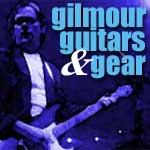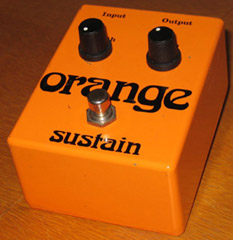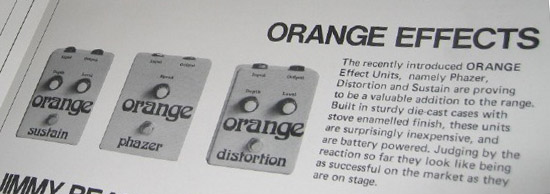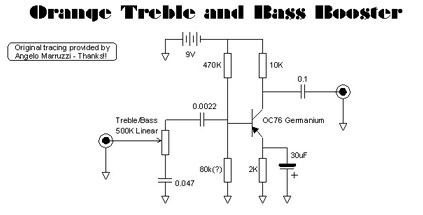
Gilmour, Guitars & Gear
Treble Boosters
More questions than answers

In this column, I'll be examining Pink Floyd guitarist David Gilmour's gear and playing techniques from a musician's point of view. Please feel free to e-mail me with questions and ideas for future articles if you feel you have an idea that readers of Spare Bricks might find of interest. Past articles are now posted here.
The 1960s were a revolutionary time for the electric guitar. Artists such as the Kinks, Eric Clapton, and Jimi Hendrix added distortion to their guitar sounds, adding a thick fuzz to the guitar in a way that had not been heard before. Towards the late 1960s, some players felt their tone was too thick and started using treble boosters to give their sound clarity and a cutting edge. I remember listening to a sound clip of a guitar with a treble booster playing "The Lemon Song" by Led Zeppelin, from 1969's Led Zeppelin II, and I realized that a treble booster was an integral part of the vintage guitar tones from that era.
Fans have long assumed that Gilmour also started using a treble booster around this time. Gilmour was running a Fuzz Face into his Hiwatt amplifiers and a treble booster seemed like a logical addition. But a look at the early years of Pink Floyd reveal a few flaws with this theory.
Hiwatt amplifiers are known for providing a crystal clear high-end to guitar tones. It's possible that a treble booster would not have been necessary.
 An early 1970s Orange Sustain pedal.
|
By 1972, however, when Pink Floyd began performing Dark Side of the Moon, it became obvious that Gilmour was using a treble booster of some sort during "Time" and "Money". This continued in live performances of the album through 1975 and is well documented by existing audience recordings from this era. In some recordings, such as the Harvested title Steel Breeze, the treble booster is obvious, while on other evenings one can only guess that Gilmour simply forgot to turn the pedal on.
So the question becomes "Which treble booster did Gilmour use?" and this is where things get confusing. By now, those who have followed Gilmour's gear through the years, assume that it's the Orange Treble and Bass Boost pedal. After doing some research, I realized there are three questions that lead me to the conclusion that this information may be incorrect.
Where did the listing of an Orange Treble & Bass Boost appear as a pedal used by Gilmour? I traced this back to his first interview in Guitar Player magazine, published in the May 1979 issue. On page 33, Gilmour's choice of effects through the years is discussed. Author Steve Rosen writes, "In 1972 all the pedals were built into a special cabinet, although since then he has gone through several different setups. Gilmour's current stage panel consists of... an Orange treble and bass boost pedal..."
Going by this article, the Orange Treble booster is listed as a part of his current stage setup (1979, the year the article was published) not his past stage setup (1972) so there's a strong possibility this statement was misread.
We then turn to the most obvious question, "Why are there no pictures of an Orange Treble & Bass Booster, anywhere?" Through the years, we've seen pictures of most of Gilmour's early equipment. These include silver and blue Fuzz Face pedals, his DeArmond volume pedal, his Vox wah pedal, his Uni-Vibe, and even footswitches to control his Binson Echorec. These effects were seen at the Pink Floyd Paris Exhibition from 2003-2004. Many of these older effects were photographed for an article titled "Relics" that appeared in the July 1995 issue of Guitarist magazine. This article covered all of Gilmour's gear preceding the 1994 tour for The Division Bell. In each instance, an Orange Treble & Bass Boost pedal was never shown. This applies not only to Gilmour; an Orange booster has never been seen in reference to any other guitarist or even music shop specializing in rare vintage equipment. This leads me to my third and final point.
 A 1970s Orange catalog.
|
Some recent evidence indicates Orange may never have made a Treble & Bass Boost pedal. There was an auction recently for two Orange pedals on eBay. As proof of their authenticity, the seller posted a photo of a catalog from the early 1970s. According to this catalog, Orange made three pedals. A Sustain, a Phazer, and a Distortion. Now there's a possibility that the Sustain pedal was mistakenly referred to as a treble booster, but that seems unlikely. The possibility also exists that Orange made a Treble & Bass Boost pedal before or after that catalog was printed, but again, there is no evidence to confirm this.
On March 4, 1976, Pete Cornish started work on a custom effect pedalboard for Gilmour. The board, to which the May 1979 Guitar World article is referring, included a Colorsound treble and bass boost unit. I tend to agree that the treble booster changed between 1975 and Gilmour's next Pink Floyd tour in support of Animals in 1977. In 1975, Pink Floyd were performing Dark Side of the Moon in its entirety as a second set. In 1977, "Money" was an encore that was performed during every show. There's definitely a difference in the treble edge of the guitar sound between those two tours.
 A schematic for the Orange Booster.
|
If you Google an image for the phrase 'Orange Treble Bass Boost' you'll get a schematic for the pedal, yet there are no pictures of the pedal. eBay listings include various homemade pedals built to the specifications of that schematic, yet no one has seem an original pedal. Treble booster pedal company BSM has created the OR treble booster, based on the Orange unit. It's quite remarkable that a pedal that no one can prove exists has made this kind of impact on the guitar effect industry. This could be the definitive Gilmour, Guitars & Gear urban legend.
